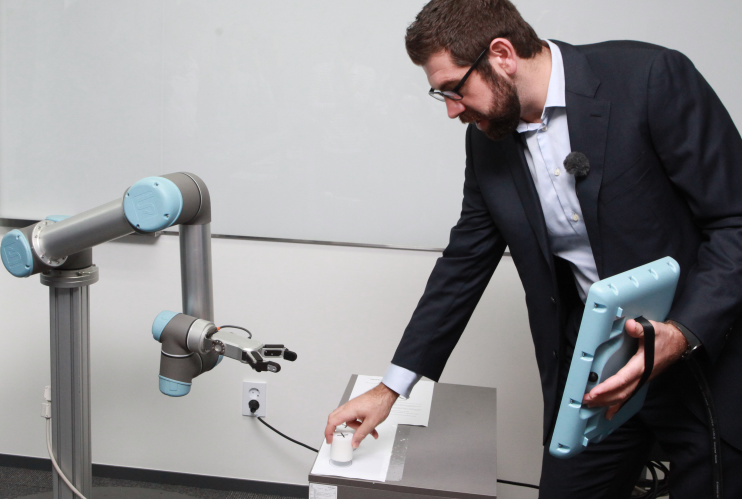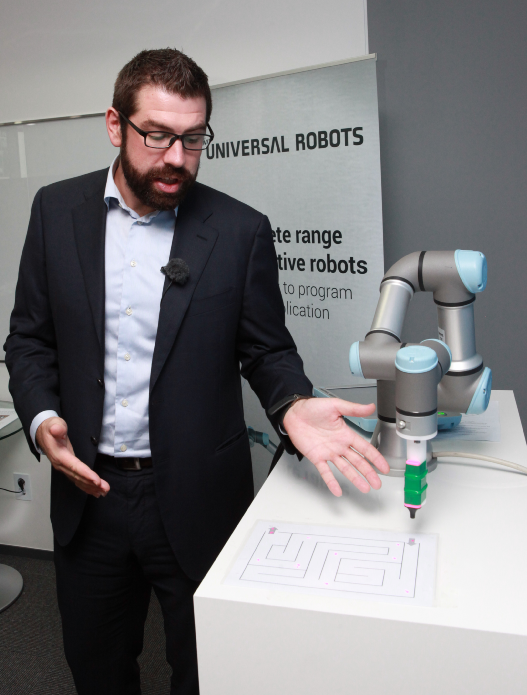전 세계에 사용자 친화적인 협동로봇을 제공하고 있는 유니버설로봇(Universal Robots)이 지난 8일, 로봇을 직접 프로그래밍하고 동작할 수 있는 ‘테크니컬 워크숍’을 개최했다.
이 행사의 목적은 유니버설의 협동로봇이 얼마나 높은 유연성과 정확도를 지녔는지, 또한 얼마나쉬운 프로그래밍이 가능한지 보여주는 시간이었다. 행사에 참여한 참석자들은 UR5를 작동하여 원통의 물체를 바스켓에 옮겨 담는 “픽 앤 플레이스(Pick and Place)”와 펜을 쥐고 있는 UR3를 움직이며 종이 위에 그려진 미로를 빠져 나오는 “미로 찾기(Maze Run)”를 체험했다.
유니버설로봇, 직접 프로그래밍하고 동작하는 테크니컬 워크숍 개최
7월 설립된 한국지사 본격적인 운영…‘유니버설로봇 플러스’도 소개
#시연 1 장면: 협동로봇 UR5가 차례대로 원통의 물체를 집어 바스켓에 넣을 수 있도록 프로그래밍에 도전한다. 티치 펜던트(Teach Pedant) 뒷면의 버튼을 사용하여 로봇을 프리 드라이브 모드로 설정한다. 각 포지션을 웨이포인트로 저장하기 전에 로봇을 손으로 움직여 정확한 위치에 둔다. 설정 명령을 통해 출력 채널을 켜고 끄면서 그리퍼를 열거나 닫을 수 있다. 대기 명령을 내려 다음 웨이 포인트를 넘어가기 전 그리퍼가 충분한 시간을 가지고 완전히 닫힐 수 있도록 설정한다. 이렇게 프로그램된 UR5 로봇은 자동으로 물체를 집어 원하는 곳에 넣는 작업을 자동으로 반복한다.
#시연 2 장면: 이번에는 협동로봇이 미로 속 길을 찾아 그릴 수 있도록 프로그래밍에 도전한다. 프리 드라이브 모드로 설정 되어 있는 로봇을 손으로 움직여 펜 끝이 미로의 주요 지점에 위치할 수 있도록한다. 각각의 주요 지점을 웨이포인트로 저장하여 로봇이 어떤 방향을 선택해야 하는지 지정한다. 포인트를 다 정했다면 로봇을 종이로부터 이동한 후 프로그램을 작동시킨다. 이제 로봇은 자동으로 움직이며 미로를 벗어날 수 있는 길을 그리게 된다.
앞서 소개한 시연 장면 1, 2는 엔지니어가 아닌 비전문가가 협동로봇을 직접 프로그래밍하여 작업할 수 있다는 것을 보여준 사례다. 시연에 참여한 기자는 엔지니어에게 약간의 도움을 받아 로봇을 작동하는 간단한 프로그램에서 동작까지 구현했다. 조작 판의 몇 번의 터치만으로 시연에 성공하기까지 걸린 시간은 5분도 채 되지 않았다.
전 세계에 사용자 친화적인 협동로봇을 제공하고 있는 유니버설로봇(Universal Robots)이 지난 8일, 로봇을 직접 프로그래밍하고 동작할 수 있는 ‘테크니컬 워크숍’을 개최했다.
 ▲ 앤드류 피터(Andrew Pether) 총괄 책임자가 로봇팔이 물건을 집고 지정된 장소에 놓는 '픽 앤 플레이스'를 설명하고 있다.
▲ 앤드류 피터(Andrew Pether) 총괄 책임자가 로봇팔이 물건을 집고 지정된 장소에 놓는 '픽 앤 플레이스'를 설명하고 있다.
이 행사의 목적은 유니버설의 협동로봇이 얼마나 높은 유연성과 정확도를 지녔는지, 또한 얼마나쉬운 프로그래밍이 가능한지 보여주는 시간이었다. 행사에 참여한 참석자들은 UR5를 작동하여 원통의 물체를 바스켓에 옮겨 담는 “픽 앤 플레이스(Pick and Place)”와 펜을 쥐고 있는 UR3를 움직이며 종이 위에 그려진 미로를 빠져 나오는 “미로 찾기(Maze Run)”를 체험했다.
이번 체험을 통해 유니버설로봇의 UR5 또는 UR3를 직접 프로그래밍하고 작동시키는 시간을 가졌다. 엔지니어가 아닌 체험자들은 UR APAC 기술지원총괄 책임자인 앤드류 피터(Andrew Pether)의 도움을 받아 프로그래밍에서 동작까지 로봇을 조정했다. 이들은 태블릿PC처럼 생긴 조정판을 들고 프로그래밍 순서대로 로봇팔의 위치를 지정하며 몇 가지 단계 거친 후, 자동으로 로봇팔이 물건을 집어 지정된 곳에 놓는 모습을 지켜봤다. 미로 찾기도 마찬가지다. 평면에 그려진 미로를 빠져나가는 포인트를 위치별로 지정하여 프로그래밍하면 완성된 프로그램대로 로봇팔이 선을 그리면서 미로를 탈출했다. 간단한 미로찾기를 응용하면 산업 현장에서 페인트나 도료 등을 접착하는데 응용이 가능하다. 물론 속도를 조절하거나 직각이 아닌 곡선도 구현할 수 있다.
앤드류 피터 총괄책임자는 협동 로봇의 안전성을 강조하는 데에도 많은 시간을 할애했다. 유니버설로봇은 국제표준화기구(ISO)에서 발표한 협동로봇 가이드라인 ISO/TS 15066를 준수하는 뛰어난 안전 기능을 갖추고 있다고 강조했다. 사람과 나란히 서서 협력하거나 독자적으로 작업할 때 안전하고 정확하게 작동할 수 있도록 설계되어 있다는 것.
앤드류 책임자는 이번 행사를 통해 ‘쉬운 프로그래밍, 높은 유연성’을 재차 강조하며 유니버설로봇의 협동 로봇이 전문인력 부족으로 어려움을 겪는 중소기업에 좋은 솔루션이 될 수 있을 것이라고 강조했다.
한편, 회사는 최근 출시된 ‘유니버설로봇 플러스(Universal Robots+)’의 특징 및 사용법도 상세히 소개했다. 올 6월 독일 오토메티카 전시회에서 공개된 ‘유니버설로봇 플러스’는 로봇 본체에 연결하면 바로 사용할 수 있는 ‘플러그 앤 플레이(Plug & Play)’ 어플리케이션 솔루션의 쇼룸이다. 유니버설로봇 어플리케이션을 설치한 후 바로 사용하고자 하는 고객들에게 새로운 편리함을 제공한다. 유니버설로봇은 ‘유니버설로봇 플러스’의 출시로, 유니버설로봇에 적용될 어플리케이션의 개발 기간 단축 및 추가 비용 절감뿐만 아니라, 사용자 편의성 증가도 가능하게 됐다.
 ▲ 앤드류 피터(Andrew Pether) 총괄 책임자가 '미로찾기' 프로그래밍을 설명하고 있다.
다음은 앤드류 피터 총괄책임자와의 일문 일답 내용이다.
-비 전문가가 프로그래밍과 동작을 실현시킬 수 있는 시연을 보여줬는데 보다 정밀한 작업도 가능한가.
▲ 앤드류 피터(Andrew Pether) 총괄 책임자가 '미로찾기' 프로그래밍을 설명하고 있다.
다음은 앤드류 피터 총괄책임자와의 일문 일답 내용이다.
-비 전문가가 프로그래밍과 동작을 실현시킬 수 있는 시연을 보여줬는데 보다 정밀한 작업도 가능한가.
그렇다. 정확도가 0.1mm이기 때문에 정밀한 작업도 가능하다. 정밀한 작업을 위해서는 정밀한 작업에 맞는 그리퍼를 사용한다든지 그런 액세서리를 바꿔서 활용하면 된다. 시연에서는 수동으로 위치를 잡는 것을 보여줬지만, 인터페이스를 통해 화살표를 지정하거나 공간들의 숫자를 직접 기입해서 보다 정밀한 작업을 할 수 있다.
-정밀도를 높이기 위해 또 어떤 것들을 지원하는가.
애플리케이션에 따라 툴이 다를 수 있기 때문에 굉장히 작은 족집게 같은 것을 활용해서 정밀한 작업을 수행할 수 있다. 그러기 때문에 우리는 유니버셜로봇 플러스를 통해 업체들이 많은 어플리케이션을 개발할 수 있도록 지원하고 우리 제품과 연결해서 사용할 수 있도록 하고 있다.
-유니버설로봇은 페이로드(가반중량) 중심의 로봇을 계속 출시하고 있는데, 10Kg이상이나 듀얼 암과 같은 다양한 유형의 로봇 출시 계획은 없는가.
덴마크 R&D센터에서는 그러한 다양한 제품 개발을 진행하고 있다. 현재는 듀얼 암과 같은 제품은 없지만 UR의 인터페이스를 통해서 두 가지 제품을 함께 사용하는 것은 가능하다.
-안전성을 위해 사용하는 주요 기술이 하드웨어인가 아니면 소프트웨어인가.
우리는 힘센서를 사용하지 않고 위치센서와 알고리즘과 같은 하드웨어와 소프트웨어를 같이 사용해서 안전성을 높이고 있다.
-유니버설로봇 플러스를 통해 그리퍼와 같은 액세서리를 직접 구입할 수 있는가.
유니버설로봇 플러스에서 직접 구매할 수 있는 것은 아니다. 구매하기 위해서는 각 제품의 링크사이트를 통해 판매자의 제품을 구매할 수 있다. 유니버설로봇 플러스 플랫폼에 올라가기 위해서는 시판되는 제품이어야 한다. 한국 개발자들이 UR 어플을 만들기 위해 이미 지원했으며 더 많이 참여할 수 있었으면 좋겠다.
-그럼 그런 방식을 통해 하드웨어와 소프트웨어를 모두 구매할 수 있는가.
하드웨어와 소프트웨어 모두 구매 가능하다. USB와 하드웨어가 같이 오게 되고 USB를 컨트롤러에 플러그인만 하게 되면 자동으로 화면이 만들어진다.
-ISO 15066 표준 지침은 공식적인 표준인가. 또한 강제로 따라야 하는 지침인가.
안전성을 위한 3자 지침은 국제 표준을 사용하는데 도움을 주는 지침들이다. 국제 표준을 해석해서 공장에서 이렇게 사용하면 된다, 라고 회사들의 지침(가이드라인)이다. ISO 표준이 복잡해서 기술적으로 단순화해서 가이드라인을 제공해 주는 것이다. 이해하도록 도와주는 것이지 3자 지침을 반드시 따라야 하는 것은 아니다.
-로봇 본체와 부착물과의 프로그램 또는 통신 방식의 호환성은.
호환성은 문제 없다. 인터페이스에 케이블로 플러그인할 수도 있고, I/O 인터커넥트가 있기 때문에 컨트롤박스에 직접 연결할 수도 있다. 이에 산업용 프로토콜과도 연결되고 USB도 연결할 수 있다.